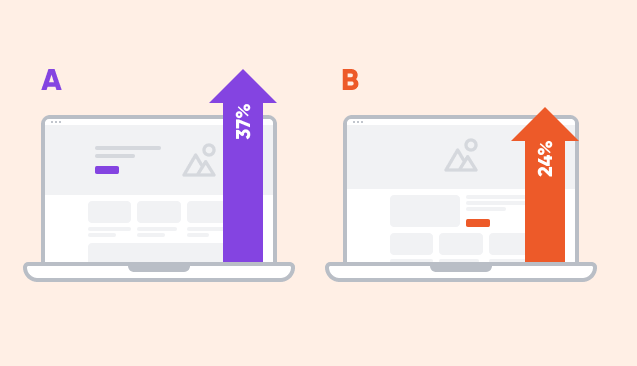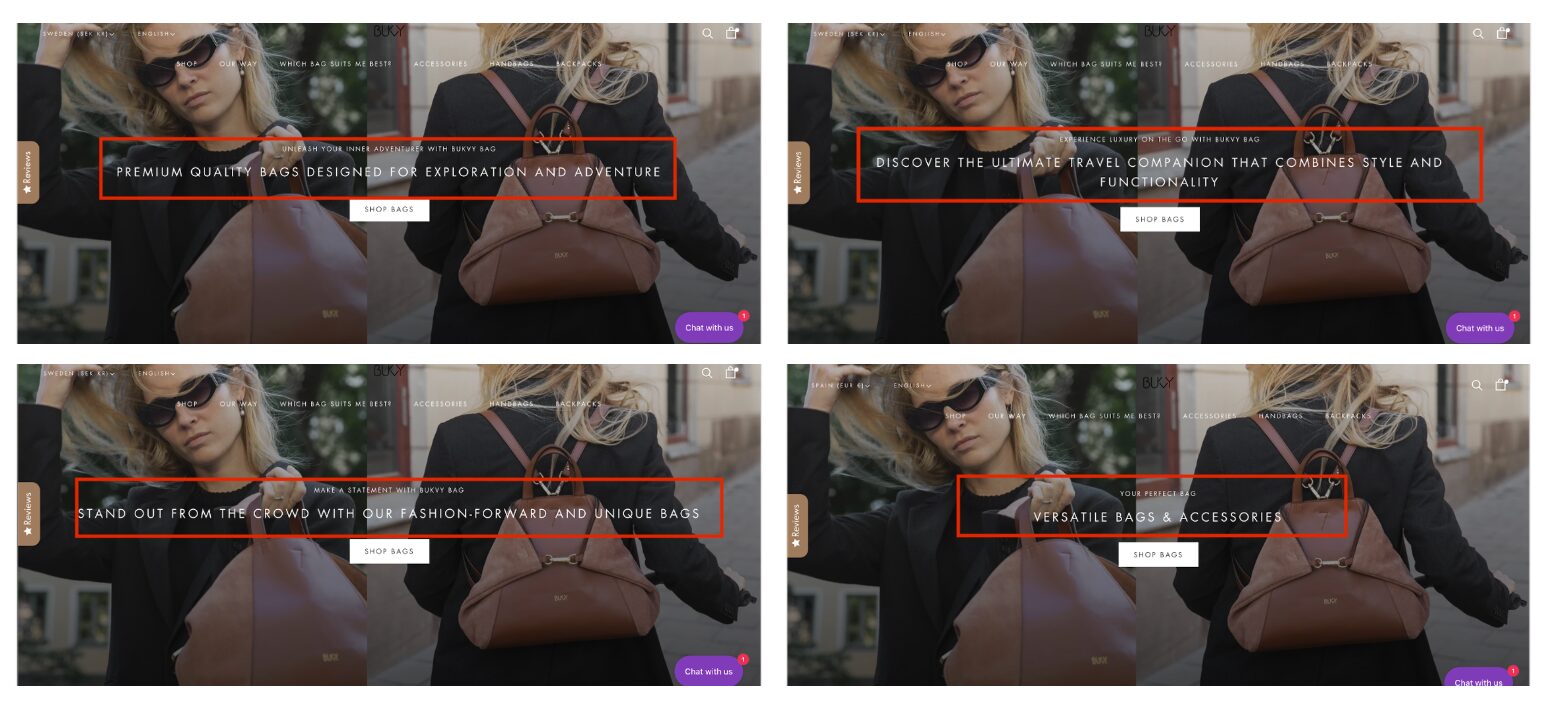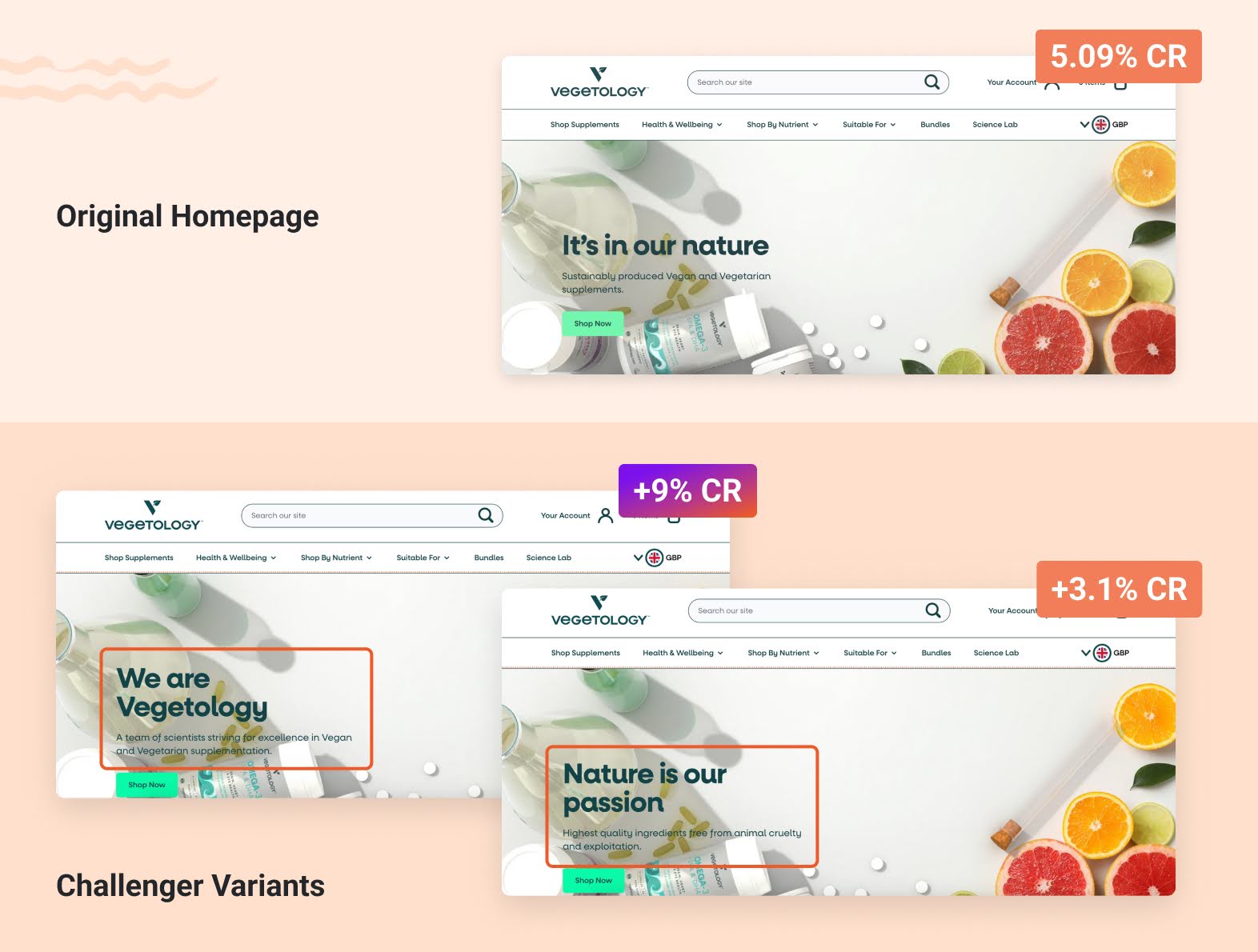- Blog
- An Ultimate Guide to Headline A/B Testing
An Ultimate Guide to Headline A/B Testing
-
Barbara Bartucz
- Conversion
- 6 min read
Table of Contents
“Make it simple. Make it memorable. Make it inviting to look at. Make it fun to read.”
That’s what advertising legend Leo Burnett once said about a good copy, and he wasn’t wrong. It’s true for headlines as well.
But that’s not enough to create high-converting headlines. If your headlines don’t resonate with your audience or highlight the wrong value proposition, you’re likely missing out on clicks, conversions, and, ultimately, revenue.
Luckily, there’s a way to fix that: A/B testing your headlines. In this article, we’ll walk you through the headline testing process and show you how to craft headlines that get clicked.
Let’s dive in!
Why do headlines matter?
First off, let’s discuss why you should care about your headlines.
Headlines are the digital equivalent of a first impression. They’re what makes someone decide whether to dive into your content or keep scrolling.
In the fast-paced world of online content, you have mere seconds to capture your audience’s attention.
Your headline is your only shot to convince someone that what you’ve written is worth their time. A powerful headline can drastically increase engagement, click-through rates, and even conversion rates.
Imagine your content as a house—no matter how well-decorated the interior, if the front door (your headline) doesn’t look appealing, no one’s stepping inside. That’s why getting your headline right is crucial.
What is A/B testing?
A/B testing, or split testing, is a method used to compare two versions of a web page or specific element (like a headline) to see which one performs better.
By randomly showing different headlines to different segments of your audience, you can determine which version gets more clicks, engagement, or conversions.
It’s like a digital showdown where the strongest headline wins.

How to get started with headline AB testing?
OK—we’ve got the basics down. Now it’s time for a step-by-step guide on how to get started with A/B testing.
Step 1: Choose your tools
The first step in headline A/B testing is selecting the right tools. There are many choices out there, with a variety of features and pricing options.
OptiMonk stands out with its Smart A/B testing feature, which is incredibly user friendly, especially for those focusing on headline testing.

This tool can automatically generate new headline variants for you, making the testing process smoother and more efficient.
Step 2: Define your goal
Before you start testing, you need to know what you’re aiming for. Are you trying to increase clicks, boost engagement, or drive more conversions?
Clearly defining your goals will help you measure success more effectively. For example, if your primary goal is to increase click-through rates, that’s the metric you’ll focus on when analyzing the results.
Step 3: Create variants
With your goal in mind, it’s time to create different headline variants—at least two of them. They can differ in wording, length, tone, or emotional appeal.
OptiMonk’s Smart A/B testing feature is particularly handy here, as it generates new variants for you automatically, saving you time and effort. Of course, you can edit these variants or add new ones to the list.

Step 4: Run the test
Once your headlines are ready, launch the test and let it run. It’s essential to let your test gather enough data to ensure your results are statistically significant.
A common mistake is to stop the headline test too early, leading to inconclusive or inaccurate results.
Patience is key, and it will pay off. Let the numbers tell the story.
Step 5: Analyze the test results
After your test has run its course, it’s time to dive into the data. Which headline drove more clicks? Which one had a higher conversion rate?
OptiMonk’s detailed analytics provide you with all these insights so you can easily determine the winner.

How to create effective headlines for your headline test?
A successful headline test starts with well-crafted headline variants. Here are some tips to help you create winning headlines.
1. Be clear and concise
Your headline should clearly communicate the value of your content in as few words as possible.
The internet is full of distractions, and readers won’t spend time deciphering what your headline means. Avoid vague or overly complex language—your audience should immediately understand what they’ll get from clicking your link.
For example, ButcherBox—a popular meat delivery service— nails this by making sure their headlines are straightforward and direct. “Dinner is solved” focuses on the customer’s main problem and leaves no room for ambiguity.

When crafting your own headlines, ask yourself if your audience will immediately understand the benefit. If the answer is yes, you’re on the right track.
2. Use power words
Power words are your secret weapon in headline writing. These are words that trigger an emotional response, making your headline more compelling.
Words like “ultimate,” “essential,” “proven,” and “unbeatable” can add a sense of urgency or importance that encourages readers to click.
Imagine you’re writing a headline for a blog post about productivity. “10 Proven Strategies for Boosting Productivity” is much more enticing than “10 Strategies for Boosting Productivity.” The word “proven” adds credibility and suggests that these strategies are backed by evidence.

Next time you’re crafting a headline, sprinkle in a power word or two and see how it transforms your headline’s impact.
3. Incorporate numbers
Headlines that include numbers tend to perform better. Why? Because they promise specific, quantifiable information.
For instance, “5 Tips for Better SEO” is more attractive than “Tips for Better SEO.”
Numbers signal to readers that your content is easy to digest and actionable.
Check out this example from Obvi. They’ve incorporated two numbers, maximizing the impact of their headline:

4. Ask questions
Questions are a powerful tool for engaging your audience. A well-crafted question can pique curiosity and compel readers to seek out the answer. When your headline asks a question, it invites the reader into a conversation—one that they’re more likely to click through to finish.
For instance, a headline like “Are You Making These Common Headline Testing Mistakes?” does more than just inform; it challenges the reader. They’ll be driven to click just to make sure they aren’t making any errors that could harm their headline testing efforts.
This technique is particularly effective when you want to spark curiosity or concern.
5. Test emotional appeal
Emotions drive decisions, and your headlines are no exception. Experimenting with emotional triggers in your headlines can reveal what resonates best with your audience.
Whether it’s curiosity, excitement, or the fear of missing out (FOMO), different emotions can significantly influence click-through rates.
For example, a headline like “Don’t Miss Out on These Game-Changing Running Tips” sparks FOMO, encouraging the reader to click before it’s too late.
On the other hand, a headline like “Unlock the Secrets to Effortless Time Management” appeals to the reader’s desire for ease and efficiency. Testing various emotional angles allows you to discover which emotions your audience responds to most.
3 successful headline testing examples
Looking for inspiration? Here are three brands that nailed their headline testing.
1. Crown & Paw
Let’s start with Crown & Paw’s headline testing. They wanted to fine-tune their messaging to better align it with their target audience.
Their goal was to find the perfect headline that would connect with potential customers on an emotional level while clearly conveying the product’s value.
By experimenting with 3 different headline variants, they were able to pinpoint the most effective wording that resonated with their customers.

By carefully testing and refining their headlines, they managed to significantly enhance their messaging, which directly resulted in a 3.5x increase in sales.
Check out their case study here.
2. Bukvybag
Bukvybag’s approach to headline A/B testing focused on enhancing user engagement and improving conversion rates.
They wanted to understand how different value propositions would impact their audience’s behavior.
By testing headlines that varied in tone and emotional appeal, they were able to discover which messages best captured their audience’s attention.

Through strategic headline A/B testing, Bukvybag achieved a 50% improvement in click-through rates and a 30% boost in their overall conversion rate.
Learn more about their approach here.
3. Vegetology
Vegetology, a brand offering plant-based supplements, used headline A/B testing as a key part of its strategy to drive more traffic to its site and increase sales.
By comparing different headline options, they identified the wording that best motivated their audience to take action.

Vegetology’s commitment to headline A/B testing resulted in a 20% increase in website traffic and a 15% uplift in sales.
Their success story is detailed here.
FAQ
How long should I run my A/B test?
Run your A/B test until you gather enough data for statistically significant results. This usually takes at least a week, but it can vary based on your traffic volume. It’s important to avoid making decisions based on too little data.
Can I test more than two headline variants at once?
Yes, you can use multivariate testing to compare multiple headlines simultaneously. Just keep in mind that the more variants you test, the more traffic you’ll need to achieve conclusive results.
What if my test results are inconclusive?
If your results are inconclusive, try running the test longer or tweaking your headline variants. Sometimes, a small adjustment or a different approach can reveal what works best.
How to decide which one is the winning headline?
The winning headline is the one that best meets your defined goals—whether it’s clicks, engagement, or conversions. Analyze the data and choose the headline that consistently outperforms the others in your key metrics.
Wrapping up
Headline A/B testing is a powerful tool if you want to improve your marketing efforts.
By regularly split testing and refining your headlines, you can maximize the effectiveness of your landing pages and drive better results for your business.
Remember, the key to success is not just in the testing but in understanding and acting on the results.
So, start testing today with OptiMonk—your next winning headline is just around the corner!
Migration has never been easier
We made switching a no-brainer with our free, white-glove onboarding service so you can get started in the blink of an eye.

What should you do next?
Thanks for reading till the end. Here are 4 ways we can help you grow your business:
Boost conversions with proven use cases
Explore our Use Case Library, filled with actionable personalization examples and step-by-step guides to unlock your website's full potential. Check out Use Case Library
Create a free OptiMonk account
Create a free OptiMonk account and easily get started with popups and conversion rate optimization. Get OptiMonk free
Get advice from a CRO expert
Schedule a personalized discovery call with one of our experts to explore how OptiMonk can help you grow your business. Book a demo
Join our weekly newsletter
Real CRO insights & marketing tips. No fluff. Straight to your inbox. Subscribe now
Barbara Bartucz
- Posted in
- Conversion
Partner with us
- © OptiMonk. All rights reserved!
- Terms of Use
- Privacy Policy
- Cookie Policy
Product updates: January Release 2025








